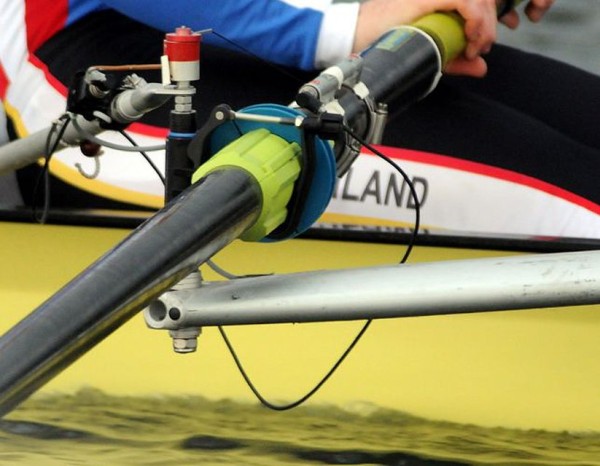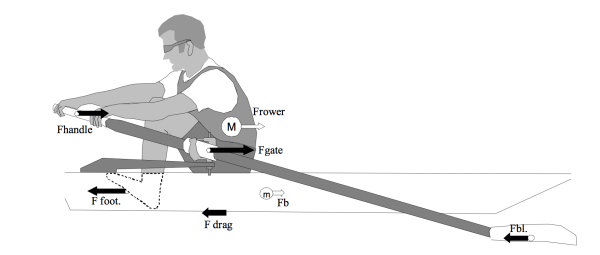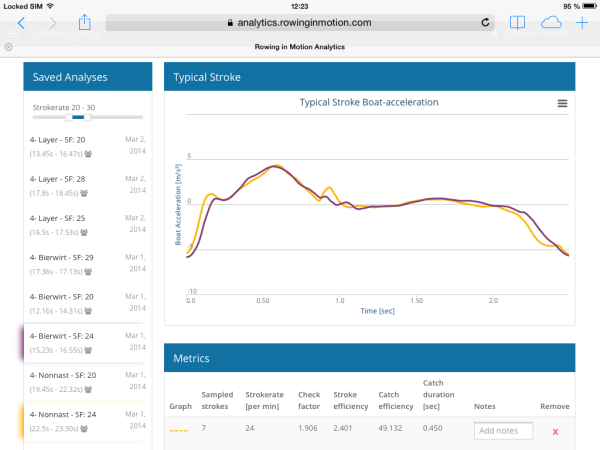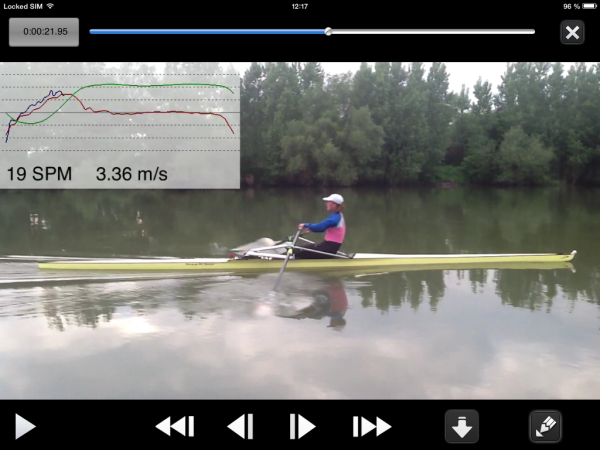Using Measurements and Biomechanic Testing in Rowing
It’s easy to agree with the statement that measuring performance in rowing is an important part of coaching. Measurements provide objective feedback to coaches and athletes facing a seemingly simple optimisation problem: how to move the boat fastest from the start pontoon to the finish-line. The crew moving their boat fastest over the race distance wins the race. In the following, we will refer to this as the rowing optimisation problem.
Faced with the task to measure performance in rowing, there’s usually a tradeoff to be made between how easy it is to measure something and how much insight can be gained from the resulting measurement data. This article deals with different aspects of measuring performance in rowing. For this purpose, the article will present the properties of measurement a measurement, followed by a discussion of various measurements commonly conducted in rowing and how those relate to the above stated rowing optimisation problem.
What is a useful measurement?
Sports is unthinkable without any kind of measurements. In the case of rowing, the two basic measurements dealt with are time and distance. The history of measuring aspects beyond these two basics goes back to as far as 1940 [1]. In order to support effective coaching, measurements should have several desirable properties. Good measurements should be:
- accurate and precise,
- comparable,
- feasible,
- understandable,
- have a clear relation to the rowing optimisation problem.
The next sections will discuss these properties in detail.
Accuracy and Precision
The value of a rowing performance measurement is directly related to its accuracy. Accuracy refers to the difference between the “true” and measured value of a parameter. When this difference is large, a measurement is said to be less accurate. Related to this is the term precision, which describes the difference in repeated measurements under the same conditions [2].
Accuracy and Precision, source http://en.wikipedia.org/wiki/File:Accuracy_and_precision.svg
If a measurement can’t be conducted in a reliable and accurate manner, it’s utility quickly diminishes because coaches and athletes can’t rely on it. This is even more important when measurements are used to make fundamental decisions like crew selection. However, for each type of measurement there’s a trade-of to be made between the desired accuracy and the effort required to conduct such a measurement. Fortunately enough, most parameters that we deal with in rowing can be obtained with sufficient accuracy and precision using reasonable effort, if the right kind of technology is used. There are many more aspects to consider when taking into account measurement errors [3], but what matters for interpretation of measurement data is how these errors affect the comparability of measurements.
Comparability
Comparability is not only a question of representation (e.g. graph, metrics etc.) but rather about the inherent errors associated with each measurement and whether to measurements can be compared when they were taken in different environment conditions. Measurements are more easily compared when they have good accuracy and precision and are resilient to uncontrollable changes in the environment. Precision is very important as it determines the range in which we need to treat two different measurement values as “similar”, i.e. there’s not statistically significant difference between two values. To illustrate this, assume we can measure boat speed with a precision of 0.1m/s. Now, let’s say we have two measurement values at 4.9 and 5.0 m/s. Is one boat significantly faster? Probably not, because both boats may have actually had a “true” speed of 5.0 m/s and we may have experienced a measurement error in one of the measurements. Again, this is an oversimplified model of “measurement precision” and what it means for two values to be significantly different. Accuracy is important when a measurement is compared to a different parameter or the measurement is used in a model. Sticking with the example of boat speed, when we use the speed to extrapolate the 2000m race times, measurement accuracy is important as any deviation from the true boat speed will lead to a large error in the 2000m time extrapolation.
The next important aspect of comparability is a measurements resilience to uncontrollable changes in the environment like water temperature, wind conditions etc. As rowing is an outdoor sport, we seldom have the luxury of reproducible, controlled conditions. The more these uncontrollable changes affect a type of measurement, the more difficult it is to compare two measurements taken in inevitably different conditions. This is especially true when the exact influence of uncontrolled conditions is not known or these conditions can not be measured accurately themselves (as is the case with e.g. water conditions).
Feasibility
Even when a measurement is accurate and comparable, it’s not going to be of any use if it’s so difficult to obtain that it is not measured in the first place. The easier it is to obtain a measurement, the more likely it is to make measuring a regular habit.

Instrumented Oar and Gate, source http://www.rudern.de/nachricht/news/2012/02/23/messtechnikertreffen-am-160212-in-hannover/
This is important because regular measurements provide valuable feedback to coaches and athletes and will foster a thorough understanding for the data, which in turn helps developing insights that may ultimately lead to a better solution to the rowing optimisation problem. From an athletes perspective, getting regular feedback on measurement data is very important to develop the ability to take deliberate influence on rowing performance by varying motion sequence and power application. This requires that athletes develop a mental model of how their “feeling” for the rowing motion connects to the measured outcome. This leads to the next important characteristic of a good measurement: understandability.
Understandability
There’s two sides to understanding a measurement. First and foremost, what does the measurement mean (what is measured?)? And second, what influences the measured value (what does an athlete need to change to affect the outcome)?
While understanding what is being measured may sound easy, first hand experience tells us that this is not always the case and a misunderstanding of the basic relations between time, distance, speed, acceleration and forces on the boat may easily result in misleading conclusions. Another aspect to understanding a measurement are the underlying dynamics of the measurement value (i.e. how does it change over time, how is it related to other parameters). Once coaches and athletes understand the meaning of a measurement value, the next step is finding out how to affect this value using a change in motion sequence and power application.
Relatedness
This leads us to the last important property of a good measurement: once we know what a measurement means and how to affect it, coaches and athletes need to decide on the desired outcome for such a measurement in the light of the rowing optimisation problem and implement an appropriate strategy to achieve it. This is not an easy task, given that physiological and mechanical constraints may result in complex interactions with other parameters.

Main forces on a rowing boat, source V. Kleshnev: Boat acceleration, temporal structure of the stroke cycle, and effectiveness in rowing, Proceedings of the Institution of Mechanical Engineers 2010
Most notably, some parameters may have a clear relation to the rowing optimisation problem, such as boat speed, while other parameters relation to the rowing optimisation problem is complex and may involve a number of parameters that have not been measured simultaneously (i.e. the interaction of gate and stretcher force).
Going Forward
The article presented the rowing optimisation problem and how measurements help find coaches and athletes find better solutions to it. The article presented desirable properties for measurements that make them more useful in the context of rowing. Finally, we presented measurements commonly used in rowing, their properties and relation to the rowing optimisation problem.
We hope this article provided some insight into the aspects of effectively using measurements in rowing. Rowing in Motion is dedicated to provide the rowing community with tools that make producing and analysing measurement data as easy as measuring stroke-rate is today. For this purpose, we are building an easy-to-use measurement system targeted at clubs, national teams and ambitious masters alike. While we work on the system, we’re sharing our insights and discuss the relevant parameters that we can measure in rowing and how we can measure them in detail.
- Using Measurements in Rowing – talks about what we can measure, why we should do so and what it means
- Designing a Measurement System for Rowing: The different levels of measurements in Rowing
- Designing a Measurement System for Rowing: Force and Power on the Oar
- Designing a Measurement System for Rowing: Boat Speed
- Designing a Measurement System for Rowing: Boat Acceleration and Movement
Sources:
[1] http://www.biorow.com/PS_tel_files/History%20of%20Force.pdf [2] http://en.wikipedia.org/wiki/Accuracy_and_precision [3] http://en.wikipedia.org/wiki/Measurement_uncertainty

